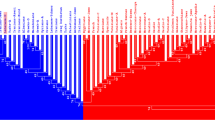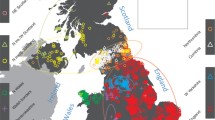Abstract
The HLA system may play an important role in natural selection processes through its involvement in immune response and because of the HLA association of some diseases. Linkage disequilibrium in the HLA system poses many interesting questions. India. a melting pot of races and cultures in sympatric isolation, provides an ideal opportunity to study these aspects. Linkage disequilibrium and haplotype data are valuable in the comparison of various populations. An analysis of the available HLA A-B haplotype data for the Indian population documents the heterogeneous nature of the latter: each endogamous caste group, major group or even regional group has its characteristic haplotype profile. The haplotypeA1-B17 is present in most Indian populations butA10-B8 occurs mostly in North India: this may be a consequence of founder effects. The haplotypeAl-B8 a typical Caucasian haplotype, is absent in the Indian subcontinent: this may be due to the selective disadvantageA1-B8 confers in the Indian environment. The different regional and caste groups of India possessing diverse haplolype combinations provide an ideal opportunity to evaluate the selective values of these haplotypes and to study human immunogenetics.
Similar content being viewed by others
References
Aizawa M 1986 (ed)Pre data analysis book II, III Asia Oceania Histocompatibility Workshop and Conference (Sapporo: Hokkaido University Press)
Aizawa M, Natori T, Wakisaka A and Konoeda Y (eds) 1986HLA in Asia-Oceania, Proceedings of III Asia Oceania Histocompatibility Workshop and Conference (Sapporo: Hokkaido University Press)
Albert E D, McClelland J D, Hammer C, Zink R and Brendel W 1972 Study of the HLA system in the Nepalese sherpa population. InHistocompatibility testing (eds) J Dausset and J Colombani (Copenhagen: Munksgaard) pp. 227–232
Arnot D, Auffray C, Boss J, Grossberger D, Kappes D, Korman A, Kuo J, Lillie J, Okada K, Roux-Dosseto M, Schamboeck A and Strominger JL 1984 The HLA-D region of the human MHC appears to have been created by a large expansion, inProgress in immunology V (eds) Y Yamamura and T Tada (New York: Academic Press) p. 187
Auffray C, Korman A J, Roux-Dosseto M, Schamboeck A and Strominger J L 1983 Analysis of human class II antigen alpha chain genes: a summary.Hum. Immunol. 8: 89
Baily G J V, Rajnarain, Mayurnath S, Vallishayee, and Guld J 1980 Tuberculosis prevention trial, Madras.Indian J. Med. Res. (suppl) 72: 1–74
Balakrishnan V 1978 A preliminary study of genetic distances among some populations of the Indian subcontinent.J. Hum. Evol. 7: 67–75
Balakrishnan V 1982 Admixture as an evolutionary force in populations of the Indian subcontinent. InProceedings of the Indian Statistical Institute Golden Jubilee International Conference. Vol. I Human genetics and adaptation (eds) K C Malhotra and Amitabha Basu (Calcutta: Indian Statistical Institute) pp. 103–145
Baur M P and Danilovs J A 1980 Population analysis of HLA-A, B, C, DR and other genetic markers. InHistocompatibility testing (ed) P I Terasaki (Los Angeles: UCLA Press) pp. 955–1210
Bodmer W F 1972 Evolutionary significance of the HLA system.Nature (London) 237: 139
Bodmer W F 1978 The HLA system.Br. Med. Bull. 34: 213–214
Bodmer W F 1984 The HLA system 1984. InHistocompatibility testing (eds) E D Albert, M P Baur and W R Mayr (New York: Springer-Verlag) pp. 11–22
Bodmer W F 1986 Human genetics: the molecular challenge.Cold Spring Harbor Symp. Quant. Biol. 51: 1–13
Bodmer J G, Kennedy L J, Lindsay J and Wasik A M 1987 Applications of serology and the ethnic distribution of three-locus HLA haplotypes.Br. Med. Bull. 43: 94–121
Bodmer W F and Thomson G 1977 Population genetics and evolution of the HLA system. InHLA and disease (eds) J Dausset and A Svejgaard (Copenhagen: Munksgaard) pp. 280–295
Ceppellini R, Curtoni E S, Mattiuz P L, Miggiano V, Scudelder G and Sena A 1967 Genetics of leukocyte antigens: a family study of segregation and linkage. InHistocompatibility testing (eds) E S Curtoni, P L Mattiuz and R M Tosi (Copenhagen: Munksgaard) p. 149
Dausset J 1975 Editorial.Tissue Antigens 5: 291–293
Dausset J 1981 The major histocompatibility complex in man: past, present and future.Science 213: 1469–1474
de Vries R P 1979The HLA system and infectious diseases, Ph.D. thesis, University of Leiden, The Netherlands.
Hammond MG, Appadoo B and Brain P 1979 HLA and cancer in South African Indians.Tissue Antigens 14: 296–302
Harris R, Wentzel J, Carroll C A and Jennison R F 1972 HLA frequencies in West Pakistanis (Punjabi) in the United Kingdom. InHistocompatibility testing (eds) J Dausset and J Colombani (Copenhagen: Munksgaard) pp. 163–170
Hurtrel B, Hurtrel M and Lagrange P 1985 Genetic control of tuberculosis DTH time course in mice, correlation with natural and acquired resistance against BCG. InGenetic control of host resistance to infection and malignancy (New York: Alan R Liss Inc.) p. 305
Kay P H, Martin E, Dawkins RL and Charoenwong P 1988 Class III gene rearrangements in Thai/Chinese supratypes containing null or defective C4 alleles.Immunogenetics 27: 46–50
McIntyre K R and Seidman J G 1984 Nucleotide sequence of mutant I-A/βhm12 gene is evidence for genetic exchange between mouse immune response genes.Nature (London) 308: 551
Mehra N K, Taneja V, Kailash S, Raizada N and Vaidya M C 1986 Distribution of HLA antigens in a sample of the North Indian Hindu population.Tissue Antigens 27: 64–74
Mitra A 1961Census of India (New Delhi: Union Publications)
Mittal K K, Naik S, Sansonetti N, Cowherd R, Kumar R and Wong D M 1982 The HLA antigens in Indian Hindus.Tissue Antigens 20: 223–226
Muller H K, Pye D W, Martin C L and Kimpton W G 1983 Tuberculosis anergy in clinically normal individuals. I. Lymphokines and lymphocyte transformation studies.Int. Arch. Allergy Appl. Immunol. 70: 65–70
Okada K, Boss J M, Prentice H, Spies T, Mengler R, Auffray C, Lillie J, Grossberger D and Strominger J L 1985 Gene organisation of DC and DX subregions of the human major histocompatibility complex.Proc. Natl. Acad. Sci. USA 82: 3410–3414
Ottenhoff T H M 1986 Evidence for an HLA-DR4 associated immune respone gene forMycobacterium tuberculosis. Lancet 11: 310–312
Pitchappan R M 1984 HLA, biological anthropology and India.Immunohaematology Bulletin ICMR 15: 1–11
Pitchappan R M 1986 HLA and India. InHLA in Asia-Oceania, Proceedings of III Asia Oceania Histocompatibility Workshop and Conference (eds) M Aizawa, T Natori, A Wakisaka and Y Konoeda (Sapporo: Hokkaido University Press) pp. 535–538
Pitchappan R M, Kakkanaiah V N, Rajasekar R, Arulraj N and Muthukkaruppan V R 1984 HLA antigens in South India: I. Major groups of Tamil Nadu.Tissue Antigens 24: 190–196
Pitchappan R M, Manickasundari M, Kakkanaiah V N, Mahendran V, Brahamajothi Bai V, Chandramohan R, Subash Chandar M and Rajasekar R 1986 HLA antigens in Sourashtrans of Madurai. InHLA in Asia-Oceania, Proceedings of III Asia Oceania Histocotnpatibility Workshop and Conference (eds) M Aizawa, T Natori, A Wakisaka and Y Konoeda (Sapporo: Hokkaido University Press) pp. 539–542
Rajasekar R 1985Studies on the HLA system of different population groups in Madurai, Ph.D. thesis, Madurai Kamaraj University, Madurai
Rajasekar R, Kakkanaiah V N and Pitchappan R M 1987 HLA antigens in South India: II. Caste groups of Tamil Nadu.Tissue Antigens 30: 113–118
Robson E B and Lamm L U 1984 Report of the committee on the genetic constitution of chromosome 6.Cytogenet. Cell Genet. 37: 47–70
Sanghvi L D, Balakrishnan V and Karve I (eds) 1981Biology of the people of Tamil Nadu (Pune and Calcutta: Indian Society of Human Genetics and Indian Anthropological Society)
Sasazuki T, Nishimura Y, Muto M and Ohta N 1983 HLA-linked genes controlling immune response and disease susceptibility.Immunol. Rev. 70: 51–75
Sheth K V, Edwards J A and Godwin J T 1985 Study of the HLA gene and antigen frequency from a Saudi Arabian hospital.Tissue Antigens 25: 156–162
Singal D P 1972 The distribution of HL-A leucocyte antigens in Indians. InHistocotnpatibility testing (eds) J Dausset and J Colombani (Copenhagen: Munksgaard) pp. 179–181
Solheim B G, Bratile A and Thorsby E 1972 study of the HLA system in a West Pakistan population. InHistocompatibility testing (eds) J Dausset and J Colombani (Copenhagen: Munksgaard) pp. 171–174
Strominger J L 1986 Human major histocompatibility complex genes: Class I antigens and tumor neurosis factors.Cold Spring Harbor Symp. Quant. Biol. 51: 63–66
Suciu-Foca H, Reed E, Khan R, Coburn C, Lewison A, Hassanali R, Rohowsky C, Susinno E and Reemtsma K 1981 HLA antigens in Asian Indians: HLA-D-DR relationships.Human Immunol. 3: 261–270
Svejgaard A, StaubNielson L, Jersild C, Jokobsen B, Ryder L P, Frelesleben E, Sorersen H, Henningsen K, Korsen G and Mizon H 1972 HLA and other polymorphisms in Turks. InHistocompatibility testing (eds) J Dausset and J Colombani (Copenhagen: Munksgaard) pp. 139–146
Tiwari J L and Terasaki P I (eds) 1985HLA and disease association (New York: Springer-Verlag)
Tran M H, Hors J, Busson M and Degos L 1978 HLA markers in the Vietnamese population.Tissue Antigens 11: 139–143
Wassom D L, Krco C J and David CS 1987 I-E expression and susceptibility to parasite infection.Immunol. Today 8: 39–43
Wolf E, Fine P E M, Pritchard J, Watson B, Bradley D J, Festenstein H, Chacko C J G and Stevens A 1980 HLA-A, B and C antigens in South Indian families with leprosy.Tissue Antigens 15: 436–446
Author information
Authors and Affiliations
Rights and permissions
About this article
Cite this article
Pitchappan, R.M. Founder effects explain the distribution of the HLAA1-B17 but not the absence of theA1-B8 haplotypes in India. J. Genet. 67, 101–111 (1988). https://doi.org/10.1007/BF02927790
Received:
Revised:
Issue Date:
DOI: https://doi.org/10.1007/BF02927790




